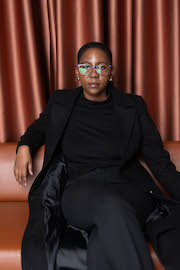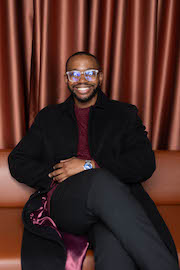Think of a copywriter with strong ideas but no access to briefs. A designer with a self-built portfolio but no way into the room. A videographer with potential, but no tools to execute.
These are the real stories behind South Africa’s youth unemployment crisis, and they represent more than just individual challenges. They signal a systemic failure in how industries, particularly marketing and advertising, engage with the youth.
Young South Africans are not short on creativity. They’re building cultural moments every day; online, in their communities, and in the ways they shape trends. But despite this, the creative economy continues to lock them out.
Often using their trends and creativity free of charge, resharing for ‘exposure’, placing them as references in presentations instead of casting them, or better yet, working with them.
The stats behind the story

According to Statistics South Africa’s Quarterly Labour Force Survey (Q1 2025), the national unemployment rate stands at 32.9%. Youth face even higher levels of exclusion: 46.1% unemployment for those aged 15–34, and a staggering 62.4% for the 15–24 age group.
Even more concerning is that 59% of unemployed youth have never had a job, and more than 75% have been unemployed for over a year. These numbers speak to more than just a labour market issue. They highlight the untapped potential of a generation that is ready to participate but is systematically excluded.
This isn’t just about joblessness. It’s about missed opportunities in creativity, innovation and cultural relevance. Brands and agencies are missing out on the very voices they often try to reach.
The industry’s blind spot
Many marketing teams continue to develop youth-targeted campaigns without involving young people in the process. This approach often results in campaigns that are disconnected from the realities, tone and cultural nuances of the audience they aim to reach.
Trying to tap into youth culture by referencing trends, memes or slang is not the same as co-creating with young people, increasing resonance. Cultural fluency cannot be downloaded. It has to be experienced, understood and built in collaboration with the people living it daily.
Youth should not be treated as a demographic to decode, they should be included as contributors, collaborators, and creators. This is especially relevant in a South African context, where young people are driving the evolution of music, fashion, language, and social conversation across the continent and beyond.
Youth-led creativity is a necessity

The assumption that young people are simply passive consumers of content is outdated. Today’s youth are content creators, trendsetters and digital entrepreneurs. They engage with culture actively, remixing, repackaging and reshaping it across platforms in real time.
Still, many creative teams build strategies about youth, instead of with them. As a result, campaigns risk falling flat, not because the ideas aren’t good, but because they weren’t built from the right perspective.
Youth-led creativity isn’t just valuable, it’s essential for relevance. It allows for work that’s not only timely but culturally resonant. For this reason, the conversation needs to move beyond representation in front of the camera and toward deeper inclusion behind the scenes, in brainstorming rooms, in strategy sessions and in decision-making spaces.
The cost of exclusion
Excluding youth from the creative economy has both immediate and long-term consequences. In the short term, it leads to work that lacks authenticity, failing to reflect the voices and cultural cues that resonate with young people.
This can result in missed opportunities for brands as it may reduce opportunities for building loyalty and trust, limiting a brand’s ability to connect and convert their most influential audience truly. In the long term, it contributes to a cycle where young people remain under skilled, underemployed and disconnected from economic opportunities due to the lack of real-world skill-building experiences, setting them up for fruitful careers.
This isn’t just a setback for young people – it leaves businesses without fresh perspectives and untapped/unguided talent that could drive innovation and resonance. Failing to bring youth into the fold today means limiting the creative leadership of tomorrow.
The data shows most unemployed youth have never had work experience, proving the issue isn’t about willingness or talent, but access. And with that access must come patience, flexibility, and a shift in how we define readiness in a world of work that’s no longer operating by old rules
The youth aren’t the future, they’re the present
It’s time to challenge the narrative that young people are “next in line.” In reality, they’re already shaping conversations, trends, and behaviours that drive consumption.
From the music we stream, to the platforms we scroll, to the language we speak, youth culture isn’t on the rise. It’s already the driving force behind mainstream culture. It shapes identity, fuels expression, and sets the tone for what’s relevant.
The brands breaking through aren’t just observing this, they’re participating in it, by collaborating directly with the generation leading it and engaging with their beliefs, expressions, and evolving behaviours from the inside out.
Waiting to involve young people until they “have more experience” overlooks the fact that they are already gaining real-world experience, just not always in formal employment settings.
What now?
Inclusion needs to go deeper than internships or youth-targeted campaigns. It’s about structural integration, giving young talent ownership in the creative process from start to finish. They need access to the work, the platforms, and the people making the decisions.
It’s no longer enough to give youth a seat at the table. They should be part of building the table, defining its shape, who sits at it, and what gets served.
For marketing to remain culturally relevant and commercially effective in South Africa, it must make space for youth-led creativity. Not just as a trend, but as a strategy. Not just for Youth Month, but throughout the year.
Atsile Songwane and Gabangaye Guliwe are from the Until Until agency, a 100% black-owned agency. Rooted in youth culture and driven by authenticity, the agency has expanded from hosting iconic events to delivering insight-led campaigns for major international brands. Until Until now offers a full suite of services across strategy, digital, content, and experiential.














